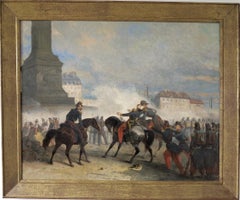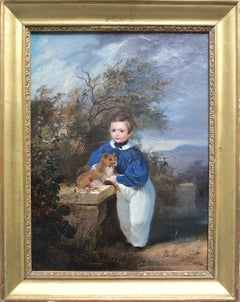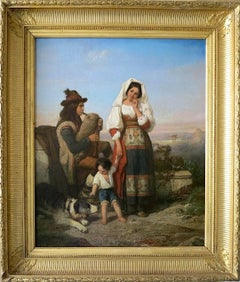Want more images or videos?
Request additional images or videos from the seller
1 of 8
Charles Zacharie LandellePortrait of a child with blue eyes184...
184...
$3,489.71List Price
About the Item
- Creator:Charles Zacharie Landelle (1821 - 1908, French)
- Creation Year:184...
- Dimensions:Height: 15.75 in (40 cm)Width: 13 in (33 cm)
- Medium:
- Movement & Style:
- Period:
- Condition:
- Gallery Location:Paris, FR
- Reference Number:Seller: T595 03 221stDibs: LU1954210221512
Charles Zacharie Landelle
Charles Zacharie LANDELLE (Laval, 1821 – Chennevières/Marne, 1908) Son of employee of the prefecture of Laval, Charles Zacharie LANDELLE accompanied his father transferred to Paris in 1827. He will not then return to Laval until the end of his life in 1895 for the inauguration of a museum of painting. Admitted in 1837 to the Ecole des Beaux-Arts, he followed the teachings of Paul DELAROCHE and Ary SCHEFFER. His career began with the production of portraits and large religious compositions - notably for the Saint-Nicolas-des-Champs, Saint-Sulpice and Saint-Roch churches in Paris - which were an immediate success and enabled him to gain recognition from the high society of the nineteenth century. He began at the Paris Salon of 1841 with a self-portrait noticed by Louis-Philippe, obtained a third class medal the following year and a first class in 1848. LANDELLE was also awarded at the Exposition Universelle of 1855 in Paris, and in Philadelphia. From then on he was able to follow a career as an official painter, between state commissions and portraits of the great people of his time (Portrait of Alfred de MUSSET, kept at the Palace of Versailles). Napoleon III bought him two paintings of the Beatitudes at the Salon of 1852 to donate to Laval, birthplace of the artist and hired him to participate in the decoration of the Salon des Aides de Camp at the Palais de l'Elysée. As early as the 1850s, LANDELLE discovered the Orient by his travels; especially Morocco, where he will have the opportunity to return on an official mission in 1866. He then realized on his return his famous Femme fellah, a work bought by the Emperor on his personal cassette, and unfortunately destroyed in 1870 in France. fire of the Château de Saint-Cloud. He then participated in a trip to Egypt in 1875, and went down the Nile with the Egyptologist Auguste MARIETTE. In 1880, LANDELLE discovered Algeria accompanied by his son Georges, also a painter. Conquered by the place, he decided each year between 1881 and 1892 to spend his winters in Algeria and to bring back some paintings or studies. LANDELLE was made knight of the Legion of Honor. Museums: Amsterdam (Mus. mun.), Londres (Wallace Coll.), Paris, (Mus. du Louvre, Mus. d’Art Mod.), Sydney, Angers, Caen, Compiègne, Laval, Nantes, Pau, Perpignan, Reims, Rouen, Strasbourg, Stuttgart, Versailles…
About the Seller
No Reviews Yet
Vetted Professional Seller
Every seller passes strict standards for authenticity and reliability
Established in 2014
1stDibs seller since 2022
13 sales on 1stDibs
Authenticity Guarantee
In the unlikely event there’s an issue with an item’s authenticity, contact us within 1 year for a full refund. DetailsMoney-Back Guarantee
If your item is not as described, is damaged in transit, or does not arrive, contact us within 7 days for a full refund. Details24-Hour Cancellation
You have a 24-hour grace period in which to reconsider your purchase, with no questions asked.Vetted Professional Sellers
Our world-class sellers must adhere to strict standards for service and quality, maintaining the integrity of our listings.Price-Match Guarantee
If you find that a seller listed the same item for a lower price elsewhere, we’ll match it.Trusted Global Delivery
Our best-in-class carrier network provides specialized shipping options worldwide, including custom delivery.You May Also Like
Portrait of a French man
By Jean Despujols
Located in BELEYMAS, FR
Jean DESPUJOLS
(Salles 1886 – Shreveport 1965)
Portrait of a Henri Martin, mayor of Saint Médard en Jalles (Gironde)
Oil on canvas
H. 75 cm; L. 60 cm
Signed lower right
around 1920/2...
Category
1920s French School Portrait Paintings
Materials
Canvas, Oil
Portrait of a man in armor
Located in BELEYMAS, FR
Attributed to Jacques DUMONT aka DUMONT LE ROMAIN
(Paris 1701 - 1781)
Presumed portrait of Louis-Joseph de Formanoir (?-1732)
Oil on canvas
H. 91.5 cm; L. 73 cm
Signed on the helmet:...
Category
1750s French School Portrait Paintings
Materials
Canvas, Oil
Portrait of young women with a white bow
By Charles Herrmann-Léon 1
Located in BELEYMAS, FR
Charles HERRMANN-LÉON (born Léon Charles Sigismond HERRMANN)
(Le Havre 1838 - Paris 1908)
Portrait of a Young Woman
Oil on canvas
H. 54 cm; W. 41 cm
Signed and dated upper right - 18...
Category
1870s French School Portrait Paintings
Materials
Canvas, Oil
Portrait of a woman in front of a landscape in a trompe l'œil
Located in BELEYMAS, FR
French school circa 1810
Portrait of a woman in front of a landscape in a trompe l'oeil
H. 106 cm; L. 91 cm
Oil on canvas
Preserved in its original vine leaf frame, this large portr...
Category
1840s French School Portrait Paintings
Materials
Canvas, Oil
$9,386
H 41.74 in W 35.83 in
Cavalry review of the 2nd Lancers regiment
Located in BELEYMAS, FR
Georges HYON
(Paris 1840 – Saint Germain en Laye 1913)
Cavalry review of the 2nd Lancers regiment
Oil on canvas
H. 115 cm; W. 146.5 cm
Signed lower left
A student of Portalis, Georg...
Category
1870s French School Portrait Paintings
Materials
Canvas, Oil
Presumed artist self-portrait
Located in BELEYMAS, FR
Louis-Gabriel BLANCHET
(Versailles, 1701 – Rome, 1772)
Presumed self-portrait of the artist
Oil on canvas
H. 73 cm; W. 60 cm
Circa 1730
Originally presented in a Restoration period frame with a "Mignard" cartouche, this beautiful painting initially appeared to us as a work from northern Italy. However, it exuded a rather French form of refinement, suggesting that its artist may have assimilated a dual influence from both sides of the Alps.
We thank our colleague and friend Philippe Mendès for spontaneously and judiciously "bringing out" the name of Louis-Gabriel Blanchet, a Romanized French portraitist, whose spirit and stylistic characteristics we clearly recognize here.
Blanchet's "French" years, before his final departure for Rome in 1728, following his winning of the second Grand Prix for painting after Subleyras in 1727, are extremely poorly documented. His father, Gabriel, was valet to Blouin, himself Louis XIV's first valet at the time. According to Thierry Lefrançois, Blanchet was one of the few students of Nicolas Bertin (1667-1736), whose studio he is said to have joined in the early 1720s. At a baptism on March 24, 1724, where he was godfather, he is mentioned as a painter in the picture store of the Duke of Antin, the director of buildings between 1708 and 1736. At this time, he was probably already married to Jeanne Quément, with whom he had a daughter also named Jeanne, who would marry Nicolas Aviet, the son of a valet in the queen's wardrobe, in Versailles in 1738.
When Blanchet arrived in Rome in October 1728, he was accompanied by Subleyras, Trémolières, and Slodtz. He enjoyed the goodwill of Vleughels, the director of the Académie de France, which had been based at the Palazzo Mancini since 1725, even though the latter was not always kind to our resident. From 1732, he was under the protection of the Duke of Saint-Aignan when he took up his post as ambassador to Rome. Along with Slodtz and Subleyras, they formed a trio of friends, joined by Joseph Vernet shortly after his arrival in Rome in 1734. Slodtz and Blanchet, on the occasion of Subleyras's marriage in 1739, were there to attest that their friend was not bound by any marital commitment, and Blanchet was a witness at Vernet's wedding in 1745.
It is most likely from these early years in Rome that our portrait of the artist dates, the expression and turn of his face irresistibly reminiscent of a self-portrait. The still relatively youthful features may correspond to Blanchet's thirty-something years, and the fluffy wig was still fashionable at this time.
The painting fits well with the depiction of a young painter wanting to display both the beginnings of success and a certain simplicity or restraint. A slight smile expresses a form of assurance in this man with a gentle, sincere gaze and a face radiating a keen sense of wit. We find here the air of intimacy present in almost all of Blanchet's portraits, even those from the 1750s and 1760s, as well as an almost complicity with the viewer. The spirit of the painting is quite close to that of the presumed portrait of Bouchardon (painted around 1730) and the portrait of Pannini, painted in 1736, but it possesses a more natural quality, notably thanks to the absence of decorum. Our work exhibits the characteristics of Blanchet's paintings: elegance, luminosity (especially in the whites), vibrant and refined colors (here, the harmony of the garnet of the garment and the slate blue of the background, whose uniformity is tempered by a very sketched landscape and a grove of greenery), light complexions, rather rosy cheekbones, often full lips, and rather tight framing.
According to the Academy's rules, Blanchet's stay should have ended in the spring of 1732, but, for reasons unknown, he remained in the Eternal City until his death, as did his friend Subleyras, with whom he shared accommodation until the late 1730s. The latter regularly called upon him to collaborate on his paintings, such as The Meal at Simon's. Through Saint-Aignan's intervention, Blanchet was employed in the late 1730s by the Stuart princely family, then exiled in Italy. He notably produced copies (now lost) after Liotard of the portraits of Charles Edward and Henry Benedict, the sons of James III Stuart. The latter also commissioned three other portraits (now in the National Portrait Gallery in London), whose more formal character contrasts with the intimate spirit of Blanchet's portraits. Blanchet frequented English painters, such as the landscape painter Richard Wilson, and studied with the Scottish portraitist Katherine Read...
Category
1730s French School Portrait Paintings
Materials
Oil, Canvas
The cabbage cutter
Located in BELEYMAS, FR
Jean-Baptiste SANTERRE
(Magny-en-Vexin, 1658- Paris, 1717)
The cabbage cutter
Oil on canvas
H. 86 cm; L. 70 cm
Jean-Baptiste Santerre began his apprent...
Category
Early 1700s French School Portrait Paintings
Materials
Canvas, Oil
The pianist
Located in BELEYMAS, FR
Jean CLUSEAU-LANAUVE
(Périgueux 1914 - Paris 1997)
The Pianist
Oil on canvas
H. 46 cm; W. 38 cm
Signed lower right. Countersigned, titled, and dated on the back - 1962
Provenance: E...
Category
1960s French School Portrait Paintings
Materials
Oil, Canvas
Holy family under an oak tree on a gold background
Located in BELEYMAS, FR
French school circa 1870
Holy Family under an oak, after Raphaël, on gold background
Oil on canvas
H. 92 cm; W. 60 cm
This aesthetic curiosity takes up the very famous composition b...
Category
19th Century French School Portrait Paintings
Materials
Canvas, Oil
Portrait of a man during French Revolution
Located in BELEYMAS, FR
Antoine VESTIER, attributed to
(Avallon, 1740 - Paris, 1824)
Portrait of a man under the Revolution
Oil on canvas
H. 46 cm; L. 37 cm
Circa 1793-95
This beautiful unsigned portrait i...
Category
1790s French School Figurative Paintings
Materials
Canvas, Oil
$26,473
H 18.12 in W 14.57 in
More From This Seller
View AllThe death of General Négrier on Place de la Bastille, Paris - France
By Nicolas Edward Gabé
Located in Paris, IDF
Nicolas Edward GABE
(Paris, 1814 - Paris, 1865)
The death of General Négrier on Place de la Bastille on June 25, 1848
Oil on canvas
Signed and dated lower right
82 x 101 cm
1849
Nicolas Edward Gabé is a 19th century artist who is still little studied to this day and yet seems to have enjoyed, according to the artistic press of the time, a certain notoriety, in particular for his seascapes.
The few bibliographical elements that we have come from the Salon booklets and tell us that the artist was born in Paris in 1814, therefore shortly before the end of the Empire.
No elements on his artistic training are mentioned in the booklets, we just know that Gabé exhibited at the Paris Salon from 1835 to 1864 where he first practiced miniature then then approached easel painting, risking himself as well in still life that the seascapes, the landscape, the portrait or the hunting.
According to press articles, he also took part in various exhibitions in the provinces such as Boulogne-sur-Mer and Marseille.
Notably, Gabé did not exhibit at the Salon his large historical canvases on the revolution of 1848, which today are of obvious documentary and iconographic interest; probably for political reasons which are easily understandable to us today in view of the historical events of then.
Gabé died in Paris at the age of 51 on January 4, 1865 with a mention in the January 7, 1865 edition of L'Union des Arts: “The death of Mr. Gabé, painter, well known in the export trade in paintings as well as to the auctioneers' hotel, whose sales it supplied through its numerous navies. “
"On June 25, 1848, in front of the barricades erected in the Bastille by the insurgents of the Red Republic, General Négrier fell to death, while he was uttering words of order and conciliation". Here are the opening lines of the tribute paid by Colonel Borgarelli d´Ison, friend of General Négrier.
General Négrier belonged to a family from Maine, brought back by Marshal Lannes from emigration. Born in Le Mans on April 27, 1788, François Marie Casimir de Négrier entered, barely 18, as a volunteer in the 2nd Light Infantry Regiment. He began in 1806 with the campaigns of Prussia and Poland, during which he earned, through his bravery, the rank of sergeant and the decoration of the Legion of Honor. He made the following campaigns in Spain and Portugal, and left, with his regiment, only for the campaign of France, in 1814, after having risen successively, by actions of brilliance and by a serious wound, to the ranks of head of battalion and officer of the Legion of Honor, with which he was provided from October 1813. The Restoration retained his rank in his regiment. After having fought and wounded a second time seriously in Waterloo, Négrier was recalled in 1816 under the second Restoration. He was appointed, in 1825, lieutenant-colonel, then colonel in 1830, brigadier general in 1836, and of division in 1841. From March 1837 he participated in the conquest of Algeria.
The Revolution of 1848 found Negrier in possession of the important command of the 16th Military Division in Lille. Quaestor of the Assembly in these times which promised to be troubled, Négrier reviewed the Place de la Concorde on June 23 at around noon various mobile guard battalions. He then took the head of 2,000 men provided by the 10th and 11th legions of the national guard and bivouacked on the Place du Palais until the next day 24. On Sunday 25 at nine o'clock, the Négrier division resumed the fight towards the Saint suburb. -Antoine. The troop gains continual advantages. At around two o'clock the column of Négrier had seized the Pont Marie: it had removed the barricades from the Quai Saint-Paul, the rue de l'Etoile, the rue des Barres...
Category
Mid-19th Century French School Figurative Paintings
Materials
Oil
Full-length portrait of Jules Michel Simonet (1834-1881) as a child with his dog
Located in Paris, IDF
Benjamin Théophile CHARON-LÉMERILLON
(Paris, 1807 – Bouzareah (Algiers), 1873)
Full-length portrait of Jules Michel Simonet (1834-1881) as a child with his dog
Oil on canvas
Signed...
Category
Mid-19th Century French School Portrait Paintings
Materials
Oil
Souvenir from Italy: Pifferaro playing the zampogna with the family
Located in Paris, IDF
Joseph BEAUME
(Marseille, 1796 – Paris, 1885)
Souvenir from Italy: pifferaro playing the zampogna with the family
Oil on canvas
Signed lower left
73.5 x 60 cm
Provenance: probably...
Category
Mid-19th Century French School Figurative Paintings
Materials
Oil
Blue macaw perched on a branch
By Jean-Baptiste Oudry
Located in Paris, IDF
French school of the second half of the 19th century,
follower of Oudry
Blue macaw perched on a branch
Oil on canvas
73 x 60 cm
Category
Late 19th Century French School Portrait Paintings
Materials
Oil
People's woman of Venice, Italy
Located in Paris, IDF
Henri Auguste Cesar SERRUR
(Lambersart, 1794 – Lille, 1876)
People's Woman of Venice
Oil on canvas
Signed, located and dated
65 x 60 cm
Venice 1850
Exhibitions:
- Paris Salon of 1...
Category
Mid-19th Century French School Figurative Paintings
Materials
Oil
The cup of the king of Thule
Located in Paris, IDF
Camille METRA or METRA-HUBBARD
(Paris, 1864 – Paris, 1936)
The cup of the King of Thule
Oil on canvas
Signed lower right and dated
113.5 x 146 cm
1896
Exhibition: Salon de l'Union des Femmes Peintres et Sculpteurs de 1896 (N°627)
Camille Métra, eldest daughter of the chemist Louis Métra and Rosalie Merny, was born on November 28, 1864 in Paris. We know nothing to this day of her artistic training, however she was recognized in Parisian circles for her qualities as a figure painter and pastellist. Camille married for the first time on January 18, 1887 in Paris with Adolphe Fernand Blayn...
Category
Late 19th Century French School Figurative Paintings
Materials
Oil
Recently Viewed
View AllMore Ways To Browse
Oil Portrait Painting Red
English School Portrait
18th Century Portrait Of Woman
18th Century Portrait Of A Woman
Mercedes Benz
Flower Portrait Painting
18th Century Portrait Of A Lady
Portrait Young Girl Painting
Child Portrait Paintings
Young Woman Oil Painting
Portrait Framed 17th Century
Oil Painting Black Girl
Portrait Of Young Man
Dark Portrait
Male Vintage Portraits
19th Century Portrait Young Man
Portrait Of Child
Antique Royal Portraits



